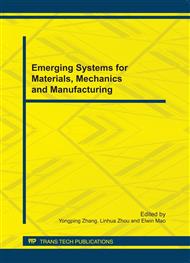[1]
W.T. Reeves: Particle Systems-A Technique for Modeling a Class of Fuzzy Objects, Computer Graphics,Vol.17(3) (1983), pp.359-376.
DOI: 10.1145/964967.801167
Google Scholar
[2]
C.H. Perry,R. W. Picard: Synthesizing Flames and Their Spreading[EB/OL], [2009-05-04]. http://pubs.media.mit.edu/pubs/papers/TR-287.ps.Z.
Google Scholar
[3]
A. Lamorlette,N. Foster: Structural Modeling of Flames for A Production Environment, ACM Transactions on Graphics,Vol.21(3) (2002), pp.729-735.
DOI: 10.1145/566654.566644
Google Scholar
[4]
M. N. Gamito, P. F. Lopes, and M. R. Gomes: Two Dimensional Simulation of Gaseous Phenomena Using Vortex Particles, in: Proceedings of the 6th Eurographics Workshop on Computer Animation and Simulation, pp.3-15, Springer-Verlag, 1995.
DOI: 10.1007/978-3-7091-9435-5_1
Google Scholar
[5]
N. Foster, D. Metaxas: Modeling the Motion of a Hot, Turbulent Gas, in: Computer Graphics Proceedings, Annual Conference Series, pp.181-188, August 1997.
DOI: 10.1145/258734.258838
Google Scholar
[6]
J. Stam: Stable Fluids, in: Proceedings of SIGGRAPH'99, pp.121-128, 1999.
Google Scholar
[7]
C. Trendall, A.J. Stewart: General Calculations Using Graphics Hardware with Applications to Interactive Caustics, in: Proceeding of Eurographics Workshop on Rendering, pp.287-298, 2000.
DOI: 10.1007/978-3-7091-6303-0_26
Google Scholar
[8]
M. Harris, G. Coombe, and et al: Physically-based Visual Simulation on Graphics Hardware, in: Proceeding of SIGGRAPH/Eurographics Workshop on Graphics Hardware, pp.109-118, 2002.
DOI: 10.1145/1198555.1198791
Google Scholar
[9]
N. Goodnight, C. Woolley, and et al: A Multi-grid Solver for Boundary Value Problems Using Programmable Graphics Hardware, in: Proceeding of SIGGRAPH/Eurographics Workshop on Graphics Hardware, 2003.
DOI: 10.1145/1198555.1198784
Google Scholar
[10]
J. Bolz, I. Farmer, E. Grinspun: Sparse Matrix Solvers on the GPU: Conjugate Gradients and Multi-grid, ACM Transactions on Graphics, Vol.22(2003), pp.917-924.
DOI: 10.1145/882262.882364
Google Scholar


